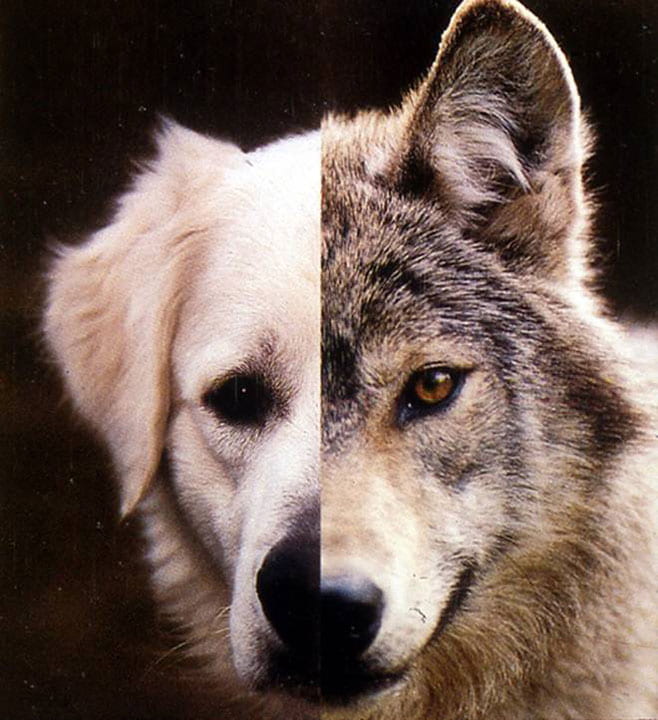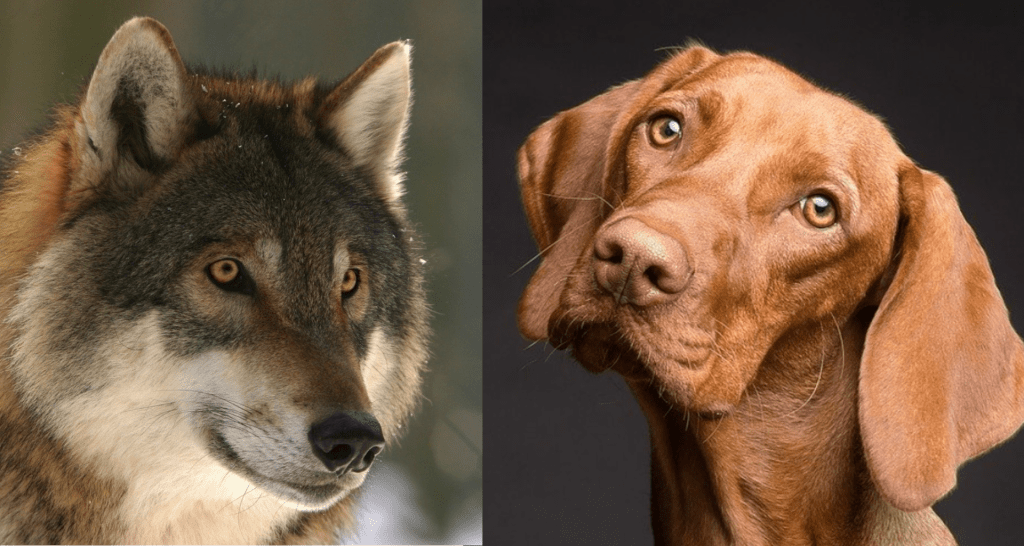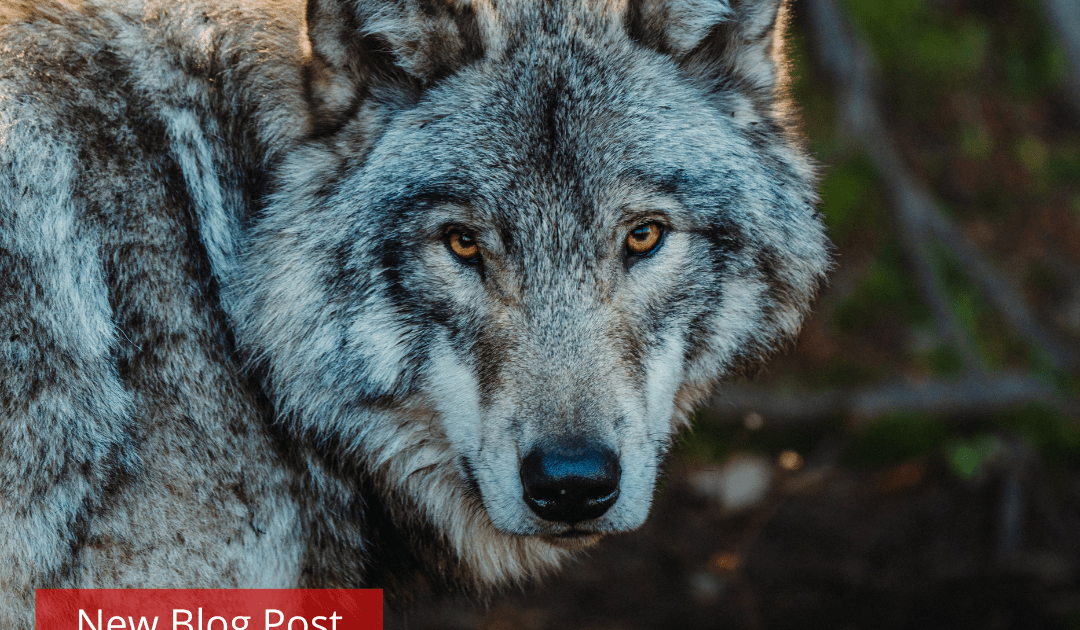Should dogs be fed a wolf diet?
Over the past few decades, many people have debated what the optimal diet is for dogs. Unfortunately, with so much information available on the Internet, it is difficult for pet owners (and even veterinary health care teams) to navigate and make the best science-based decisions for their 4-legged friends. When dog owners read on the Internet that dogs should be fed what wolves eat in the wild, is this idea based on fact? We wanted to explore the science to compare the dietary similarities and differences between domestic dogs and their ancient ancestor, the grey wolf.

What foods make up a wolf diet?
Wolves are carnivores that eat all kinds of animals, depending on the environment they live in, including mammals, birds, fish, insects, and reptiles! [1-6]. One popular belief is that dogs should eat a meat-only diet because that’s what their ancestors ate in the wild, but in fact, the wolf diet is not exclusively meat. Numerous research projects have been conducted to assess the diet of grey wolves (Canis lupus) by analyzing stomach contents and scats (feces). Plant materials like grass, leaves and berries have been found to make up a small portion of wolves’ diets, which means they don’t thrive on meat alone.[1-6].

Is a wolf diet appropriate for our domestic dogs?
The term “species-appropriate” is commonly used to describe a domestic dog diet that resembles what wolves eat in the wild. However, dogs and wolves are two different species with different dietary requirements. Dogs first became domesticated about 15,000 to 33,000 years ago during the hunter-gather period [7,8]. Both natural and artificial selection pressures resulted in dogs developing several unique genotypes and phenotypes that set them apart from their ancestors. For example, genetic studies have revealed dogs have three genes that wolves don’t have, allowing for digestion and absorption of starches (or complex carbohydrates) in the diet. This change happened over time as domesticated dogs ate the leftovers that human hunters-gathers discarded. Just like wolves, dogs do not have salivary amylase, however, their bodies have an increased capacity to digest and absorb starch, and this enhanced capacity can be traced back to three unique genes. AMY2B (encoding intestinal amylase), MGAM (increased maltase activity), and SGLT1 (increases glucose uptake). The selection for these three key genes plays an important role in allowing domesticated dogs to thrive on starch-rich diets [9].
It has also been found through research studies that dietary preferences of dogs and wolves are different. When given the choice, wolves have been found to prefer diets that are predominantly made up of protein (54%) and fat (45%). However, domestic dogs prefer diets with about 30% protein and much more fat[7,8]. It turns out that domestication has made dogs better able to digest and absorb starch (compared to wolves) and it has also changed the type of nutrients they prefer in their diet.
Another aspect to consider when comparing the diet of dogs and wolves is the difference in lifestyle which causes different nutrient needs. Although two humans may be similar in terms of age, gender and body weight, one could be sedentary with no daily exercise, while the other could be an Olympic athlete. Based on lifestyle they would have very different nutrient needs. The same is true for canine species. In the wild, wolves are active hunters that strive for the survival of the species. Reproduction and creating offspring are the major goal during their short life span. By comparison, dogs are much less active, even when we think our dogs are doing a lot of exercise. They are often spayed or neutered, so reproduction is not what we have in mind for most of them, yet we want them to stay with us for a happy and long life.
Is “natural” always better?
Not quite!
Wolves eat their food in the most natural way–they hunt, attack, kill their prey, and then eat the raw meat. No roasting the fresh catch over an open fire. With this ‘all natural’ way of living, wolves suffer from parasites, intestinal foreign bodies and other diseases, which can result in a shorter life span[10].
While it is true that the stomach acids of dogs (and people) are able to kill infectious bugs like Salmonella, they may not always do the best job if there is a heavy load. As these bad bugs get past the stomach, they can infect the small intestine and then stick around to form what are called colonies. Often these bugs end up in the feces and then contaminate the environment, which can cause illness in animals or people.
The average life span of a grey wolf living in the wild is only 5 or 6 years, but in captivity they can live between 15 and 20 years with an adequate diet and veterinary care (e.g., treatment for infections or disease)[11]. After millennia of domestication, although our companion dogs share similar features to their wolf ancestor, they are genetically different and have lifestyle and dietary needs that are unique to wolves living in the wild[12].
In conclusion: it’s important to understand that “natural” does not equal “optimal”. To achieve a long and healthy life (the “optimal” life), regular veterinary care and a balanced, safe diet should be delivered to the pets sharing your home.
Written by Zhenzhen Liu, Phase 2 DVM student and summer student @ OVC Pet Nutrition
Reviewed by Dr. Sarah Abood and Dr. Adronie Verbrugghe
.
References
[1] Ciucci, P., Boitani, L., Pelliccioni, E. R., Rocco, M., & Guy, I. (1996). A comparison of scat-analysis methods to assess the diet of the wolf Canis lupus. Wildlife Biology, 2(3), 37–48. https://doi.org/10.2981/wlb.1996.006
[2] Darimont, C. T., Price, M. H. H., Winchester, N. N., Gordon‐Walker, J., & Paquet, P. C. (2004). Predators in natural fragments: Foraging ecology of wolves in British Columbia’s central and north coast archipelago. Journal of Biogeography, 31(11), 1867–1877. https://doi.org/10.1111/j.1365-2699.2004.01141.x
[3] Tremblay, J.-P., Jolicoeur, H., & Lemieux, R. (2001). Summer food habits of Gray Wolves in the boreal forest of the Lac Jacques-Cartier highlands, Québec. Alces, 37, 1–12.
[4] Liu, B., & Jiang, Z. (2003). Diet composition of wolves (Canis lupus) in the northeastern Qinghai-Tibet Plateau, China. Acta Theriologica, 48(2), 255–263. https://doi.org/10.1007/BF03194165
[5] Andersone, Ž., & Ozoliņš, J. (2004). Food habits of wolves (Canis lupus) in Latvia. Acta Theriologica, 49(3), 357–367. https://doi.org/10.1007/BF03192534
[6] Pezzo, F., Parigi, L., & Fico, R. (2003). Food habits of wolves in central Italy based on stomach and intestine analyses. Acta Theriologica, 48(2), 265–270. https://doi.org/10.1007/BF03194166
[7] Bosch, G., Hagen-Plantinga, E. A., & Hendriks, W. H. (2015). Dietary nutrient profiles of wild wolves: Insights for optimal dog nutrition? The British Journal of Nutrition, 113 Suppl, S40-54. https://doi.org/10.1017/S0007114514002311
[8] Hewson-Hughes, A. K., Hewson-Hughes, V. L., Colyer, A., Miller, A. T., McGrane, S. J., Hall, S. R., Butterwick, R. F., Simpson, S. J., & Raubenheimer, D. (2013). Geometric analysis of macronutrient selection in breeds of the domestic dog, Canis lupus familiaris. Behavioral Ecology, 24(1), 293–304. https://doi.org/10.1093/beheco/ars168
[9] Axelsson, E., Ratnakumar, A., Arendt, M.-L., Maqbool, K., Webster, M. T., Perloski, M., Liberg, O., Arnemo, J. M., Hedhammar, Å., & Lindblad-Toh, K. (2013). The genomic signature of dog domestication reveals adaptation to a starch-rich diet. Nature, 495(7441), 360–364. https://doi.org/10.1038/nature11837
[10] Bagrade, G., Kirjušina, M., Vismanis, K., & Ozoliņš, J. (2009). Helminth parasites of the wolf
Canis lupus from Latvia. Journal of Helminthology, 83(1), 63–68. https://doi.org/10.1017/S0022149X08123860
[11] Dewey, T., & Smith, J. (n.d.). Canis lupus (gray wolf). Animal Diversity Web. Retrieved June 9, 2020, from https://animaldiversity.org/accounts/Canis_lupus/
[12] Wayne, R. K., & vonHoldt, B. M. (2012). Evolutionary genomics of dog domestication. Mammalian Genome, 23(1), 3–18. https://doi.org/10.1007/s00335-011-9386-7


